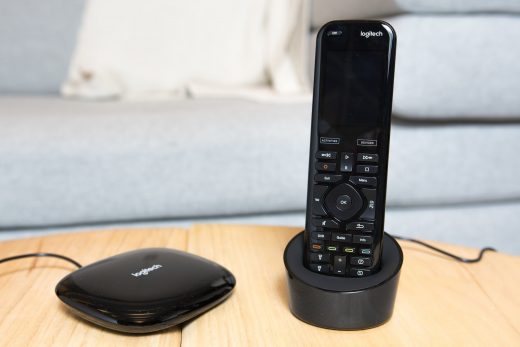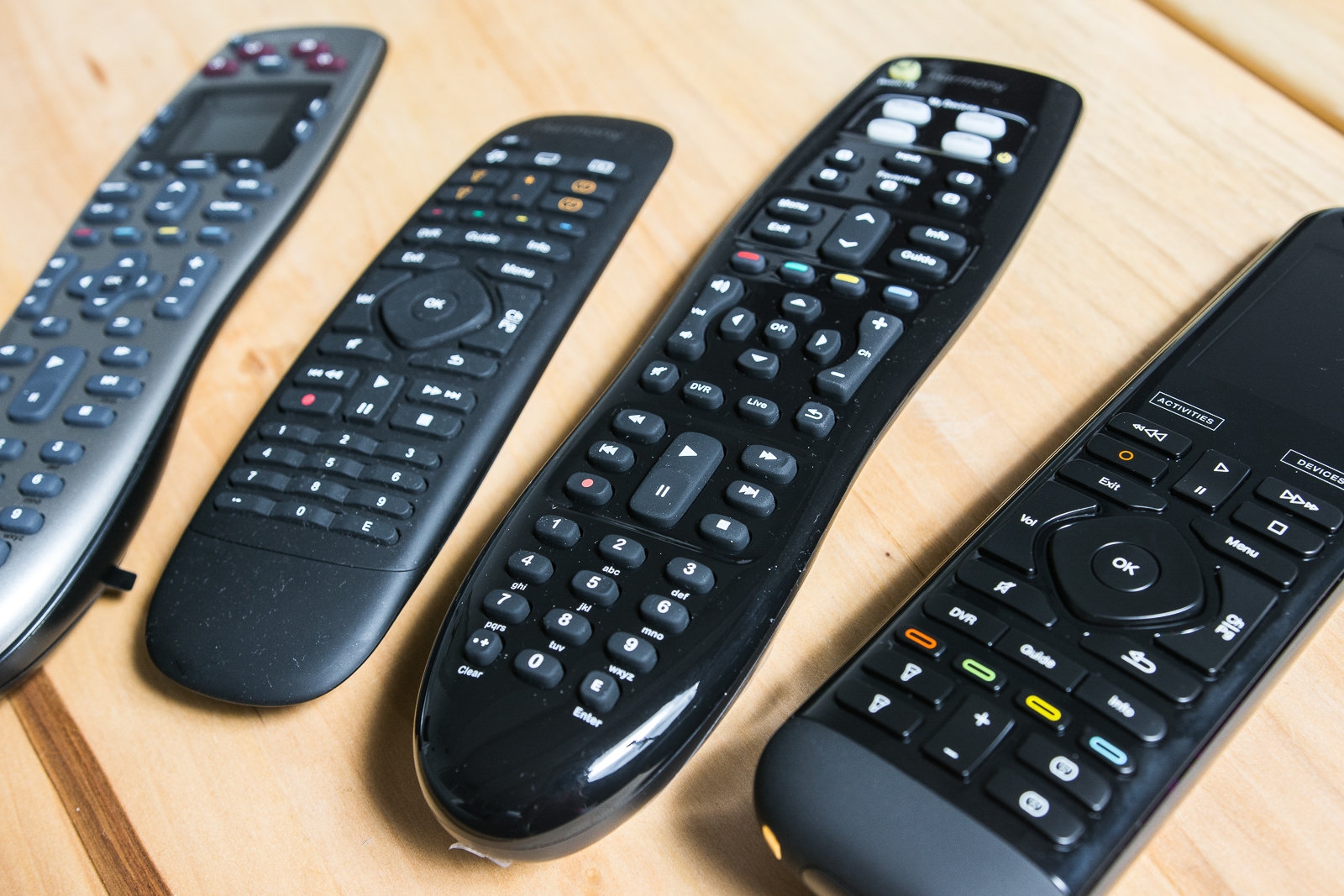The best universal remote control
By Grant Clauser and Darryl Wilkinson
This post was done in partnership with Wirecutter. When readers choose to buy Wirecutter’s independently chosen editorial picks, Wirecutter and Engadget may earn affiliate commission. Read the full guide to universal remote controls.
If you’re looking for an easy-to-use universal remote to control up to eight AV components and even some smart-home devices, we recommend the Logitech Harmony Companion. Harmony remotes are the easiest to set up, and the smart, activity-based system simplifies control of your whole home theater. No other remote control we found offers as much control, connectivity, and compatibility for the money.
The two-piece Logitech Harmony Companion system, which consists of a hub and a handheld remote, can control up to eight AV components, and it works with IR, Wi-Fi, and Bluetooth devices, which gives it more flexibility than many budget remotes have. You can also use a smartphone/tablet app to control your system. The Harmony Companion integrates with Alexa, Google Assistant, and several do-it-yourself home-automation hubs and smart devices, such as lights, locks, thermostats, and motorized shades. The remote lacks backlighting, and all of that functionality makes it a bit more difficult to program than some other Harmony remotes—but it’s still easier to use than anything else available.
If you’re looking to control a typical AV system consisting of, say, a TV, an AV receiver, a cable DVR, and a Blu-ray player, the Logitech Harmony 665 is a great choice. It’s capable of controlling up to 10 components, it features an easy-to-read, backlit color display, and the built-in Remote Assistant function is great for troubleshooting. If the remote fails to perform a task you expect it to (such as turning up the TV’s volume), you can follow the Remote Assistant’s guided suggestions to resolve the problem quickly. However, the Harmony 665 can control only IR-based equipment, so it doesn’t support smart-home devices and some streaming media players and game consoles, and it needs line-of-sight with your gear.
Like our top pick, the Logitech Harmony Elite is a two-piece system that uses the Harmony Hub, so you get all the same advantages. The flagship Elite model controls up to 15 devices and adds a customizable touchscreen for even more flexibility. The remote is fully backlit and more responsive, with a nicer design that makes it feel more like the remote for a professionally installed control system—but all of that comes with a big jump in price. This is the model to get if you have a large and expanding home theater system, and you want the best handheld remote.
Why you should trust us
Grant Clauser and Darryl Wilkinson have been writing about electronics and reviewing home technology for more than 15 years.
Grant has held editor positions for several leading consumer electronics publications, including Dealerscope, E-Gear, and Electronic House, and he has written for Sound & Vision, Big Picture Big Sound, Consumer Digest, and others. He has reviewed hundreds of products, including some of the first universal remotes. He is ISF-certified for video calibration and has completed Control4 programming and THX Level II home theater design courses.
Darryl has written for both print and online publications such as Home Theater Magazine, Digital TV & Sound, and Electronic House, and is currently editor-at-large for Sound & Vision. Prior to his reviewing career, he spent almost 14 years working for independent AV stores in both retail sales and purchasing.
Who this is for
If your home entertainment system consists of only two or three devices—such as a TV, a DVR, and maybe a DVD or Blu-ray player—you may not need a universal remote, since basic control of these devices (such as changing channels and adjusting volume) might be built into the remote that came with the TV or DVR. But if sitting down to watch TV or a movie requires shuffling between several remotes, switching inputs, and powering multiple components at the same time, a universal remote is for you. A home theater based on an AV receiver and several content sources is a prime candidate for a universal remote.
A bad universal remote simply combines all the functions of several remotes into one device and does nothing to integrate those functions in a more useful way. A good universal remote not only eliminates coffee-table clutter and the remote shuffle but also reduces button pushes by combining multiple actions into one button press. For instance, instead of having to push separate buttons to turn on your TV, switch HDMI inputs, power on your AV receiver, change inputs there, turn on your Blu-ray player, and—finally—get your movie started, a good universal remote can reduce all of that to one command (“Play Movie”) that you can access at the touch of a single button. Some remotes refer to this bundling of commands as “macros,” while the Harmony series calls them “Activities.” This functionality used to be reserved for high-end professionally programmed systems, but these days relatively inexpensive remotes (in particular, those from Logitech’s Harmony lineup) can do the same complex job.
Although $100 may seem like a lot of money to spend on a universal remote (especially since you can get a decent Blu-ray player for about that price), keep this in mind: Because your remote control is the primary device you interact with when you use your AV system, getting a single good universal remote that does the job of eight mediocre remotes is a very satisfying upgrade to that system. CNET’s David Katzmaier puts it this way: “In 15-odd years of reviewing TV and home theater equipment, the one thing I always tell people to buy is a ‘good universal remote.'”
How we picked and tested
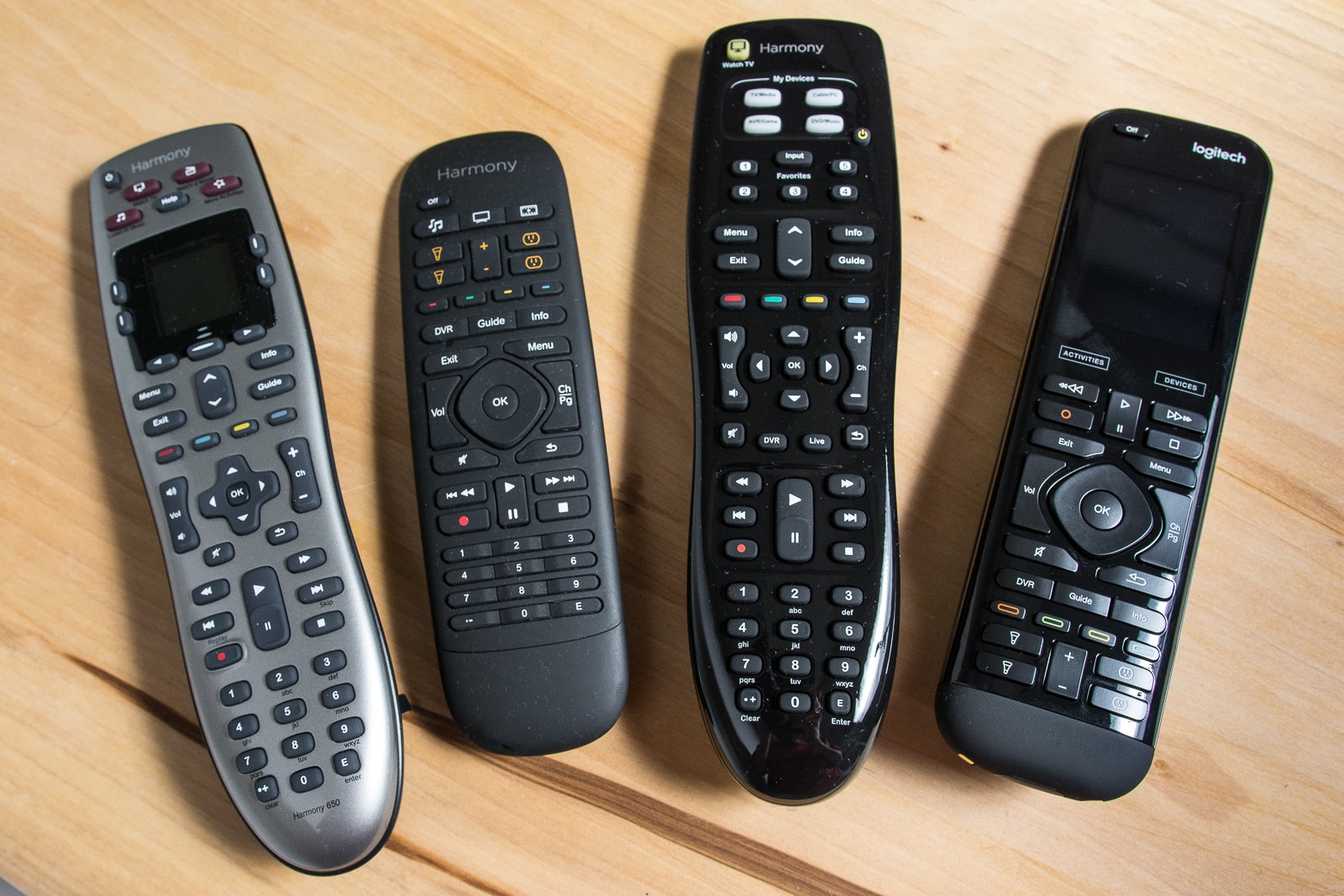
A universal remote control has to be, well, universal. That means the remote can control all the components that an average audio/video enthusiast may throw at it. A typical system has five or six devices, including a TV (or projector), a DVD/Blu-ray player, a DVR, a surround-sound receiver, and maybe a media streamer (such as a Roku or Apple TV). A game console or two might also be included. A remote that can juggle eight devices at once covers most systems.
Most devices still rely on IR (infrared) control—rather than RF, IP (Internet Protocol), or Bluetooth—so an IR remote is sufficient for most people. (If a Sony PlayStation 3 or 4 is on your gear list and you need your remote to support it, your options are a little more limited.)
In addition to supporting the right number of components, the remote should have a well-organized button layout or on-screen display, with the most important buttons (such as volume, pause, and play) easily accessible. An activity-based design, as described above, is also preferred.
Finally, we want a remote that’s easy to program. If you need a certificate in C++ to program it, that’s too difficult.
If you scan Amazon and other online retailers for universal remotes, you can find a lot of low-end replacement remotes—models whose primary purpose is to replace the one the dog chewed up and do little else. Philips used to sell a series of programmable remotes called Pronto, and Sony offered a couple of nice universal remotes in years past, but they’ve all been discontinued. The company called Universal Remote Control (appropriately enough) used to lead the pack in off-the-shelf remotes (the URC-R40 was a good example), but URC now focuses almost exclusively on control systems for professional installation.
And then there’s Logitech. These days, selecting the best universal remote is largely a matter of selecting the right Logitech Harmony device for your needs. For our testing, we requested several Harmony models at different prices, each designed to handle a different level of system complexity.
We set up each remote to control different AV systems (and, in some cases, smart-home devices) in our test home, and then we lived with each one for a while to see how intuitive and reliable it was to use on a daily basis.
Our pick: Logitech Harmony Companion
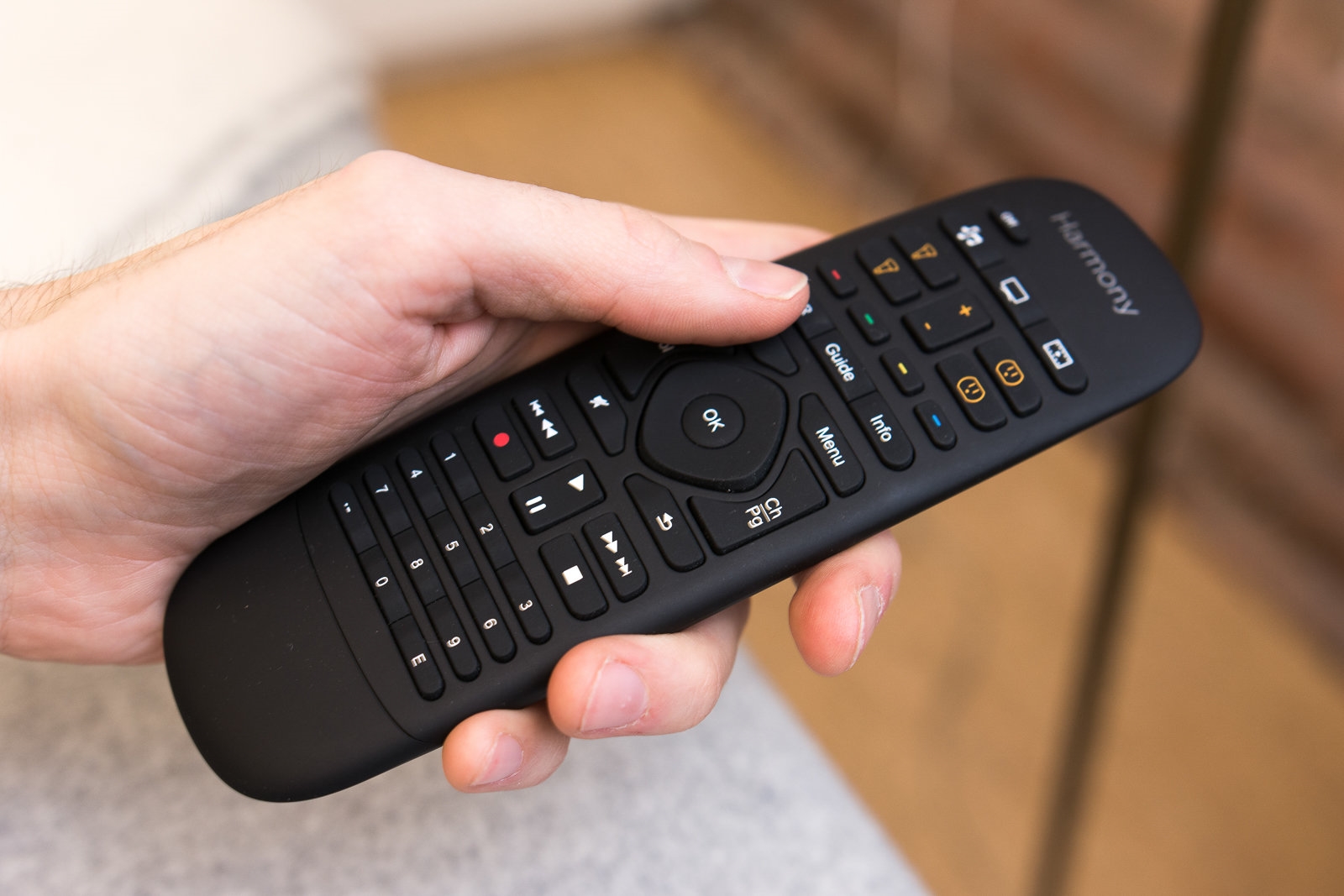
The Logitech Harmony Companion can coordinate the functions of up to eight AV components. It’s relatively simple to program with its MyHarmony software, and it uses a smart, activity-based interface that simplifies control of your whole home theater. The system works with IR, Wi-Fi, and Bluetooth devices, including a variety of smart-home products, and the free iOS/Android control app provides a second method of controlling everything. You can control the system with voice commands when you integrate it with an Amazon Alexa or Google Assistant speaker. The Harmony Companion may offer more functionality than some people need, though, which makes it a bit more expensive than a basic universal remote.
The Harmony Companion is a two-piece system consisting of a handheld remote and a separate Hub that you place next to the AV components in your system. Unlike many universal remotes, the handheld Companion remote doesn’t have a built-in IR emitter. Instead, the IR emitter, along with the Bluetooth and Wi-Fi radios, is built into the Hub. When you press a button on the Companion remote, it sends a radio signal to the Hub, telling it which button you’ve pushed. The Hub then emits the appropriate IR, Bluetooth, or Wi-Fi signal to control the associated components. Support for Wi-Fi and Bluetooth is a huge plus because it allows the Companion to control popular non-IR devices—such as the Sony PlayStation 4 and the Amazon Fire TV media player—that a basic IR remote can’t.
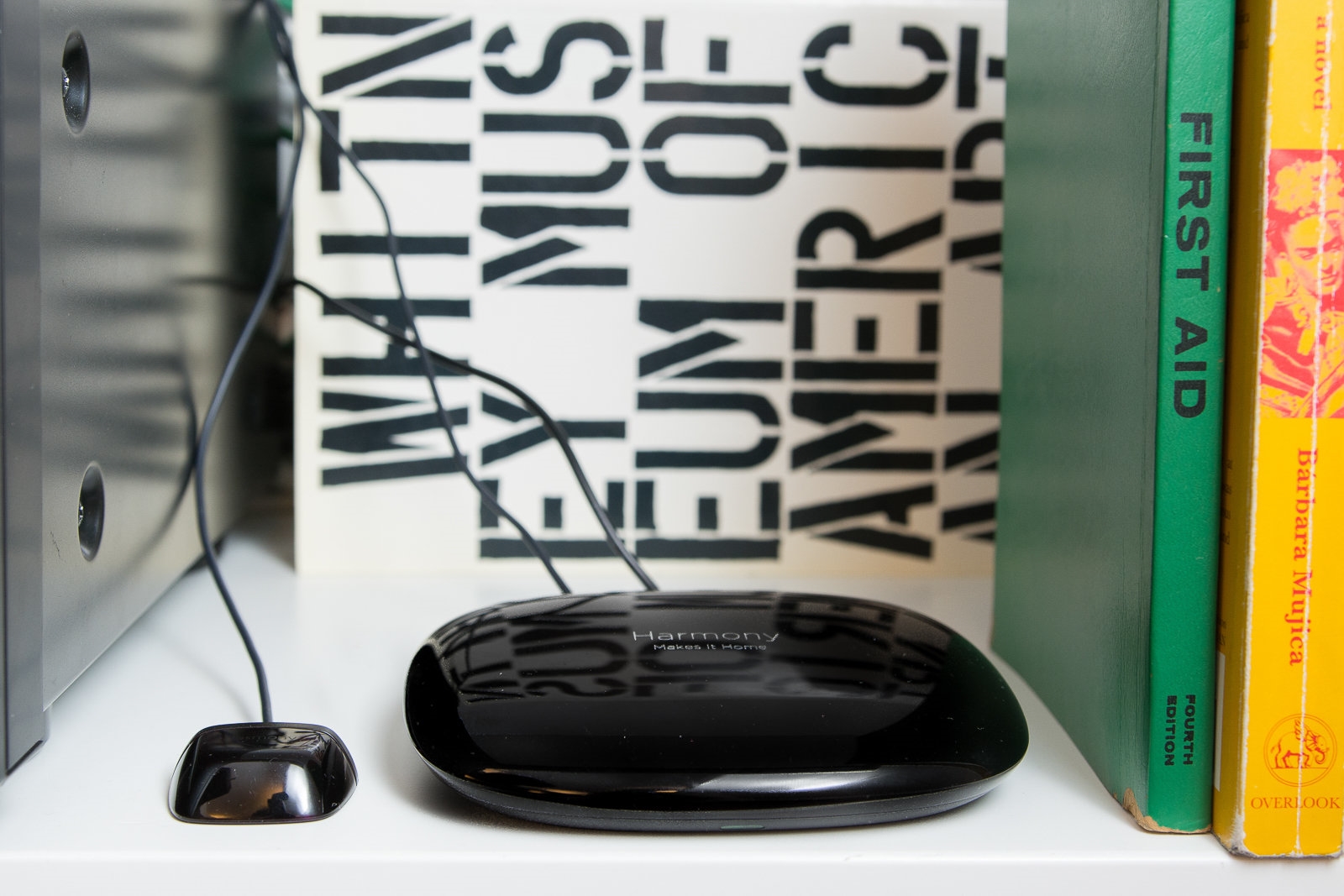
One benefit of having the IR emitters in a separate hub is that it no longer matters where you point the handheld remote. As a matter of fact, the Companion remote doesn’t even need to be in the same room as the Hub, so long as you place the Hub where the IR signals it emits can reach your AV components. This location can be inside a cabinet behind closed doors, on top of a stack of AV components, or even in another part of the room. The Hub also comes with a wired IR blaster that you can point to reach components in another direction, and it has a 3.5 mm jack for you to add a second blaster if necessary. Your Wi-Fi gear can be anywhere within reach of your wireless network, of course.
One of the highlights of the whole Harmony line is that these remotes are very simple to program, at least for universal remotes. Although no one has come up with a completely no-hassle method of programming a universal remote, the Harmony system comes the closest of any we’ve ever tested.
Initial programming of the Harmony Companion requires the use of Logitech’s MyHarmony desktop software (Windows or Mac) and a MyHarmony online account. You can register up to six different Harmony remotes under one account, by the way, in case you have more than one AV system at home. After you connect the Hub to your computer using the included Micro-USB cable, the MyHarmony software guides you through the setup process “in 3 steps.”
The first step is to add your AV devices. MyHarmony asks you to enter the manufacturer and model number of each component; it then searches for that component’s remote control codes in Logitech’s massive database and immediately adds the found codes to your list of devices. Logitech maintains and continually updates an astoundingly large remote control code database that covers more than 270,000 home theater devices.
This process is much easier than the methods for programming non-Harmony remotes. Those remotes often use the more traditional universal remote programming, which requires you to search for a specific four-digit code for each of your components in the remote’s instruction manual and then enter those on the remote itself. Afterward, you still have to turn the power of each component on or off using the remote to verify you’ve entered the correct code. If you haven’t, it’s back to the manual to find an alternate code to enter.
Once you’ve added all of your devices, MyHarmony guides you through the second step: creating Activities, which are ways of doing multiple things (such as turning on devices and switching to the correct inputs) by pressing a single button on the remote. Depending on the types of components you have—perhaps a TV, a Blu-ray player, a receiver, and a cable box—MyHarmony suggests a number of possible Activities, such as “Watch TV” or “Listen to Music” (you can also create your own custom Activities).
As you create your Activities, MyHarmony asks a series of questions, such as: “What input should your AV Receiver be set to when you watch a movie?” and “Which device controls the volume?” The Harmony software performs all the complex macro calculations in the background, so you don’t have to. Once you answer all the necessary questions, you’re done. You can assign your newly created activity to one of the three Activity buttons located along the top of the remote.
The final step is to load your newly configured remote settings into the Hub by hitting the sync button and then place the Hub wherever you’d like it to reside. When it comes time to use the remote, just press the desired Activity button, and the Harmony turns everything on and switches each device to the correct settings.
The Companion remote has a logical button layout and includes important functions such as Menu, Exit, Guide, and color buttons. The nice, rubberized texture on the front and back eliminates fingerprints and reduces the chances of the remote slipping out of your hand. It uses a single CR2032 button battery that Logitech says should last up to one year.
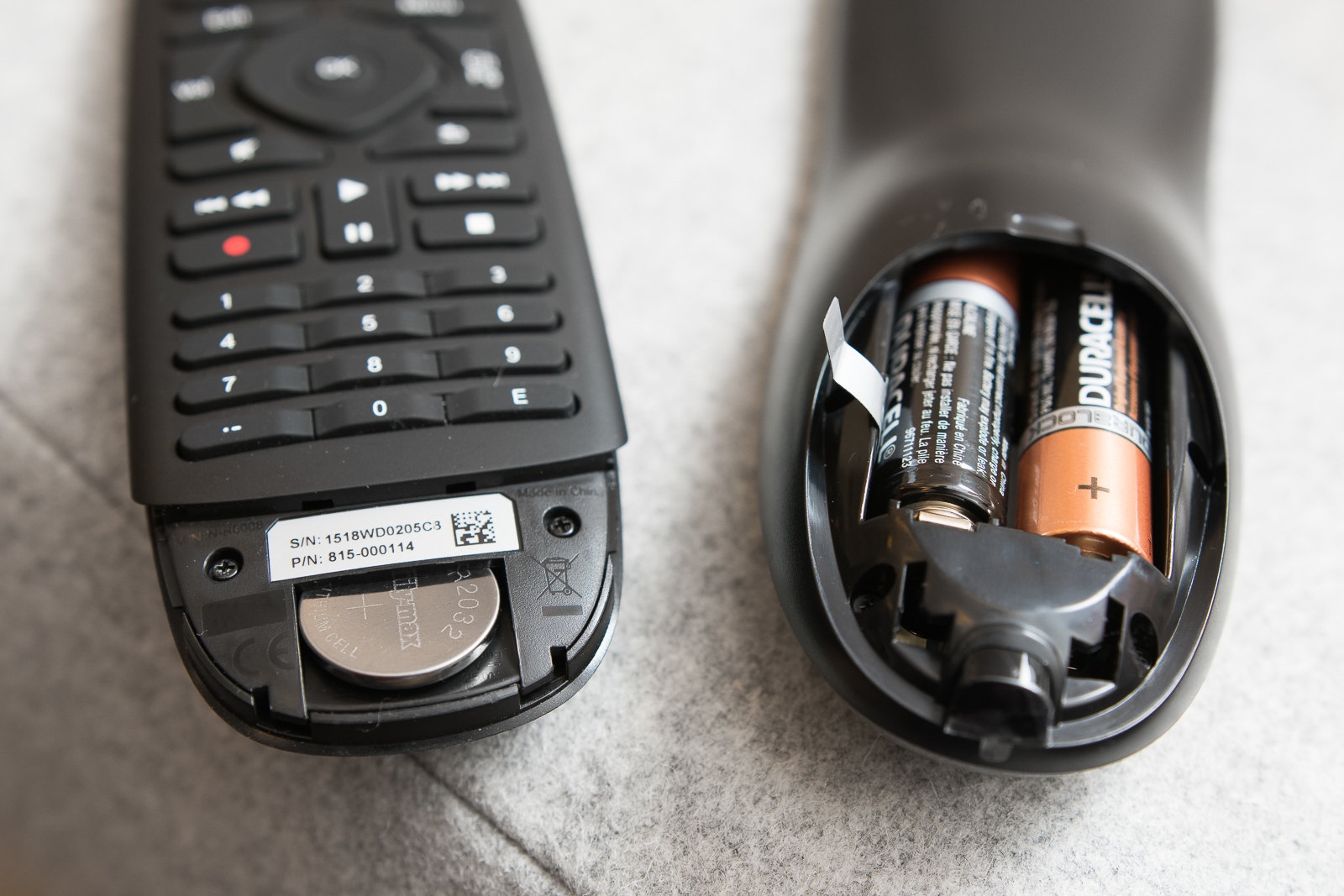
Beyond the Companion’s ability to control your AV devices, it can also serve as a basic smart-home controller. Rather than develop its own proprietary home-automation system, Logitech made the Harmony Companion compatible with several existing platforms and devices. At the moment, these include Philips Hue lighting, Nest learning thermostats, Nest Protect smoke/CO alarms, Honeywell’s Wi-Fi thermostats, Rheem EcoNet water heaters, and smart-home hubs from the Lutron Caséta and Samsung SmartThings lines. It even supports the online automation service IFTTT. You can also control your Harmony Companion with your voice by integrating it with Amazon’s Alexa or Google Assistant. However, the Companion doesn’t work with the common smart-home protocols Z-Wave or Zigbee unless you add the Harmony Hub Extender.
Basically, the Harmony Companion provides a way of unifying control of your AV system and a basic home-automation system in a seamless, albeit limited, way. The convenience and comfort benefits of controlling the lighting and even being able to adjust the thermostat while you’re watching TV makes the Companion more than just an AV remote.
Flaws but not dealbreakers
The most egregious design flaw in the Harmony Companion is that the buttons on the handheld remote are not backlit. Although it’s true that the raised buttons and intuitively organized layout make the remote easy to use by feel, that applies only if you know what each button is supposed to do. For example, if you can never remember which is the DVR button and which is the Guide button, you’ll struggle to operate the remote in the dark.
The Harmony Companion also lacks a customizable display, which means that less-used functions, such as changing your AV receiver’s surround mode or subwoofer level, aren’t accessible through the Companion remote. This model also lacks the convenient help function available in the Harmony 665 (see below). The Harmony App does offer a Fix feature that allows you to directly access incorrect settings (power and input for components, for example); it’s faster but less intuitive to use than the Harmony 665’s help function since it doesn’t provide visual prompts.
Budget pick: Logitech Harmony 665
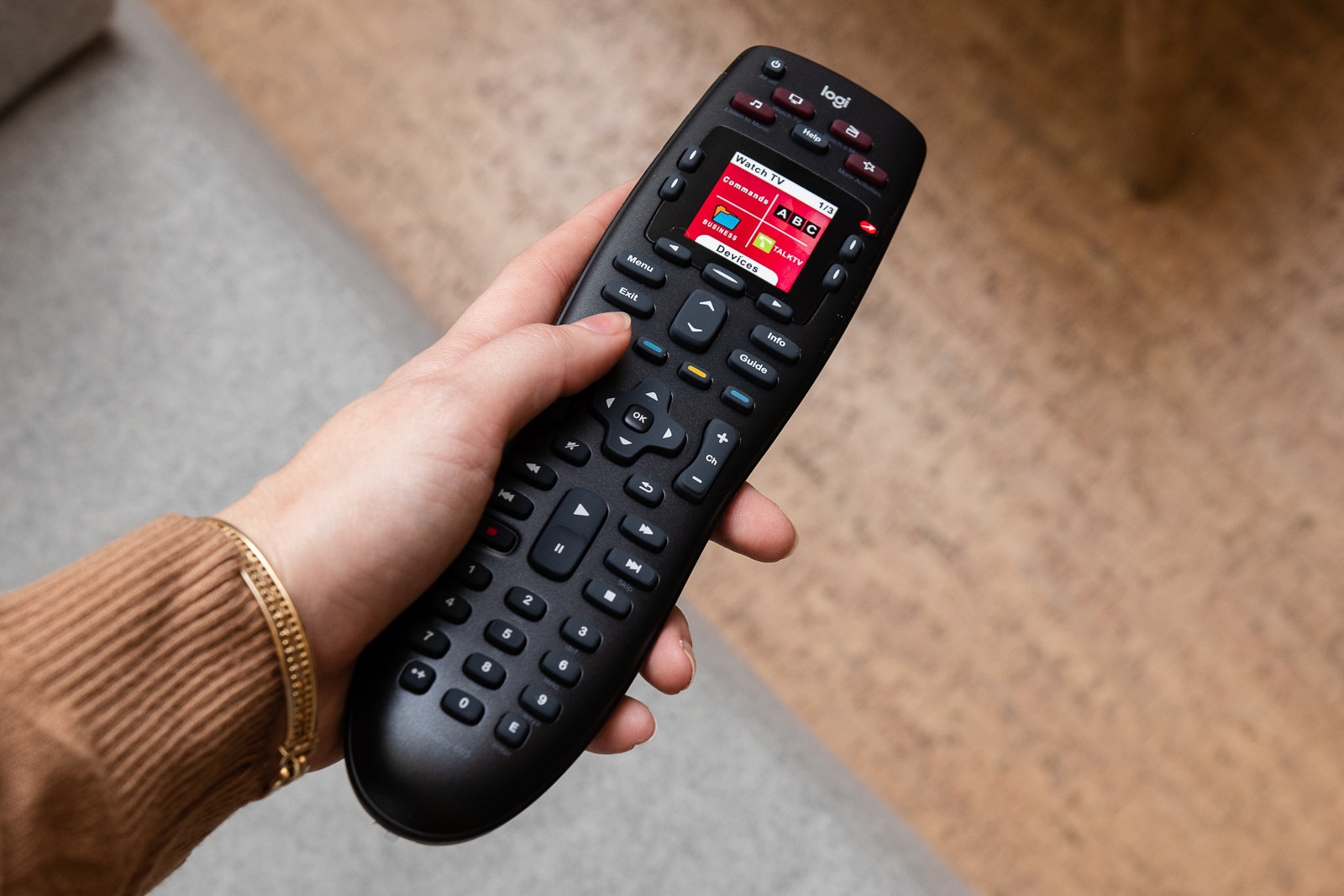
If you’re looking for a universal remote to control a traditional AV system, the Logitech Harmony 665 (a newer version of our former pick, the Harmony 650) offers 10-device control capability and the same easy setup as our top pick; it also adds backlighting, a customizable LCD screen, and a convenient help function. However, it can control only IR (infrared) devices, and since it can’t communicate over Wi-Fi or Bluetooth, it needs line-of-sight with your gear. On top of that, it isn’t compatible with some AV equipment, and it doesn’t work with smart speakers or offer the smart-home control you get from the Harmony Companion.
The Harmony 665 follows the same basic setup procedure as the Companion, relying on your interaction with the MyHarmony desktop software to add devices, set up activities, and the like. Since the Harmony 665 is a one-piece model that does not include the Hub, you need to connect the remote directly to your computer via the supplied USB cable anytime you wish to add new devices or make any changes to how the system works.
The remote itself is very comfortable to hold, with the most frequently used buttons—volume up/down, channel up/down, play/pause, and a cursor control pad for navigating on-screen menus and channel guides—all located within easy reach of your thumb. All of the raised buttons on the Harmony 665 are distinct in shape and spaced far enough apart from one another that it soon becomes second nature to operate the remote without needing to take your eyes off the TV.
Located just below the Activity buttons at the top of the remote is a color screen with two selection buttons on each side. Using this screen you can select additional Activities beyond the three already assigned to the Activity buttons; you can also use the display to access functions on components that don’t have a corresponding button on the Harmony 665, such as picture-in-picture or surround-sound mode.
By far, the most useful feature of the Harmony 665—the one that will keep you from pulling your hair out if you have a problem with the way your system is working—is the help function, which you access from a button above the display. If for some reason your TV doesn’t turn on or the receiver doesn’t switch to the correct input after you select an activity, pressing the Help button causes the Harmony 665 to immediately emit an infrared command that, ideally, rectifies the situation.
Once the Harmony 665 makes its first attempt, the query “Did that fix the problem?” appears on the color screen. If you answer yes, the help screen goes away. If you answer no, the Harmony 665 asks further questions, such as “Is the AV Receiver off?” If your answer is yes, the remote sends out a command to turn the receiver back on and then once again asks, “Did that fix the problem?” Yes turns off help; no initiates another question, and so on. This built-in help function, along with the ability to easily set up Activities, makes the Harmony 665 simple enough for nearly anyone to use.
The Harmony 665 is limited to controlling AV devices that accept infrared (IR) remote controls. For most people, that limitation isn’t an issue because it covers the vast majority of past, current, and (most likely) future AV components. However, some popular AV devices don’t use IR remotes, such as Sony’s PlayStation 3 and PlayStation 4, Sonos’s wireless speakers, Philips Hue lighting, and certain Amazon Fire TV devices. If you currently have one of those components, you won’t be able to use the Harmony 665 to control it—in other words, you’re stuck using two or more remote controls. That might not be a big deal as long as you’re happy having all your other gear under control.
Also, the line-of-sight nature of this IR remote means that the status of the components in your system might get out of sync when you start or end an activity if you don’t keep the Harmony 665 pointed in the direction of all your equipment while it emits all of the remote control commands. The more commands that are included in the activity, the more chances there are for this to happen. Generally, the help function should be able to rectify the problem, but it’s still less than perfect.
You also can’t use the Harmony 665 if you have your components tucked away in a cabinet—unless you add your own IR extenders or even add digital RF to the Harmony 665. The latter option requires you to use special two-thirds-size AAA batteries in the Harmony 665 instead of standard AA batteries.
Upgrade pick: Logitech Harmony Elite
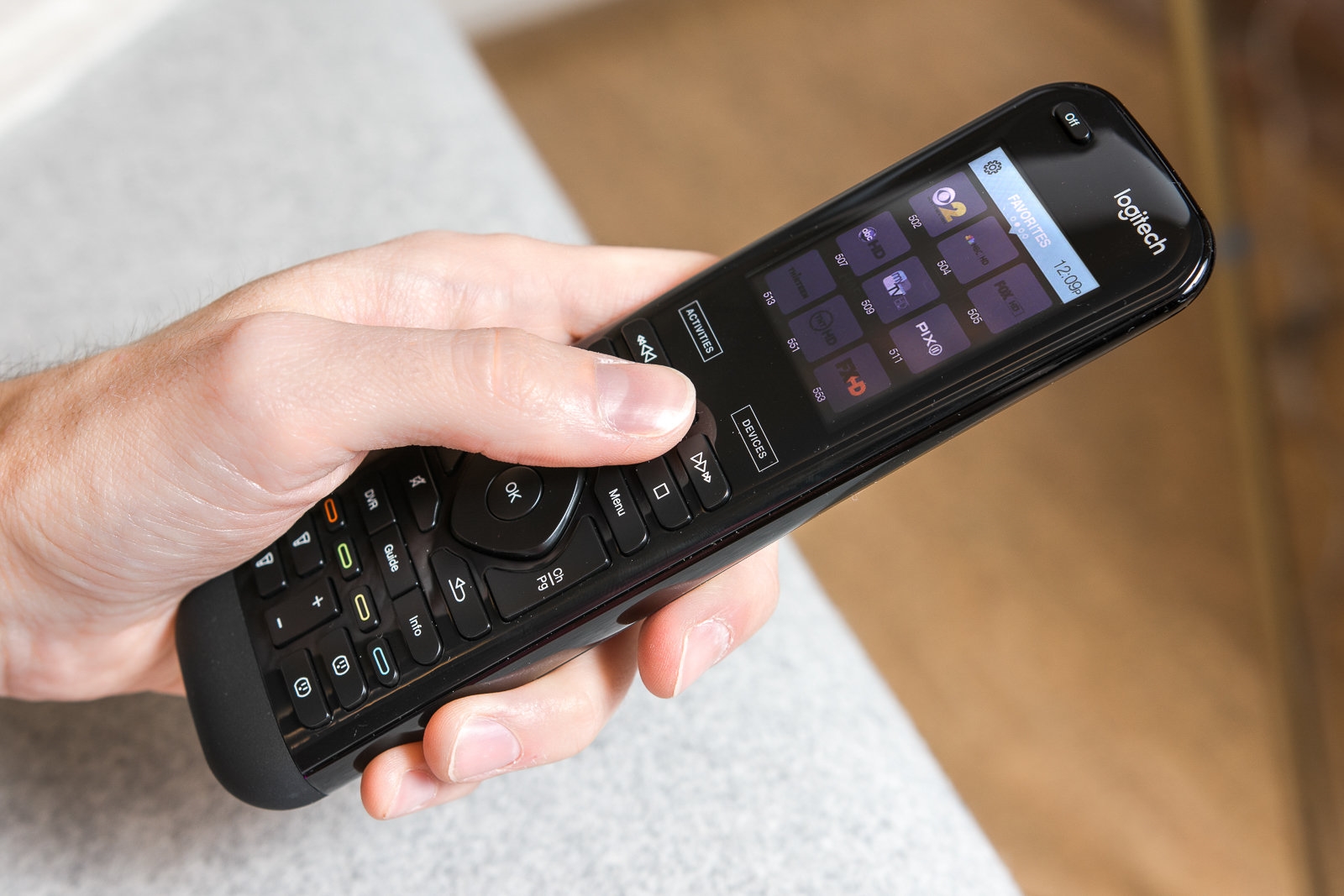
The Harmony Elite is Logitech’s flagship Harmony remote. Like the Harmony Companion, it’s a two-piece system built around the Hub, so it can control IR, Wi-Fi, and Bluetooth devices and does not need line-of-sight with your gear. Stepping up to the Elite gets you a completely customizable color touchscreen and full backlighting, plus the ability to control more components (up to 15) and to integrate even more smart-home devices into your system. Like the Companion, it also works with Alexa and Google Assistant.
The standout feature of the Elite is the color touchscreen built into the remote. Instead of pressing hard buttons for Movie, TV, or Music, for instance, you scroll up and down on the screen for your activity and tap that. The screen then switches to pages customized for that activity, and the control options can go satisfyingly deep. You can customize all the activity names, or you can create your own.
This is also the remote to get if you have a lot of gear—it can control up to 15 devices (up from the Companion’s eight-device limit), so it potentially replaces up to 15 other remotes. Like the Harmony Companion, the Elite allows you to hide your home theater equipment in a cabinet or gear closet. It comes with two IR blasters that you can position in front of the cabinet doors that keep your gear out of sight.
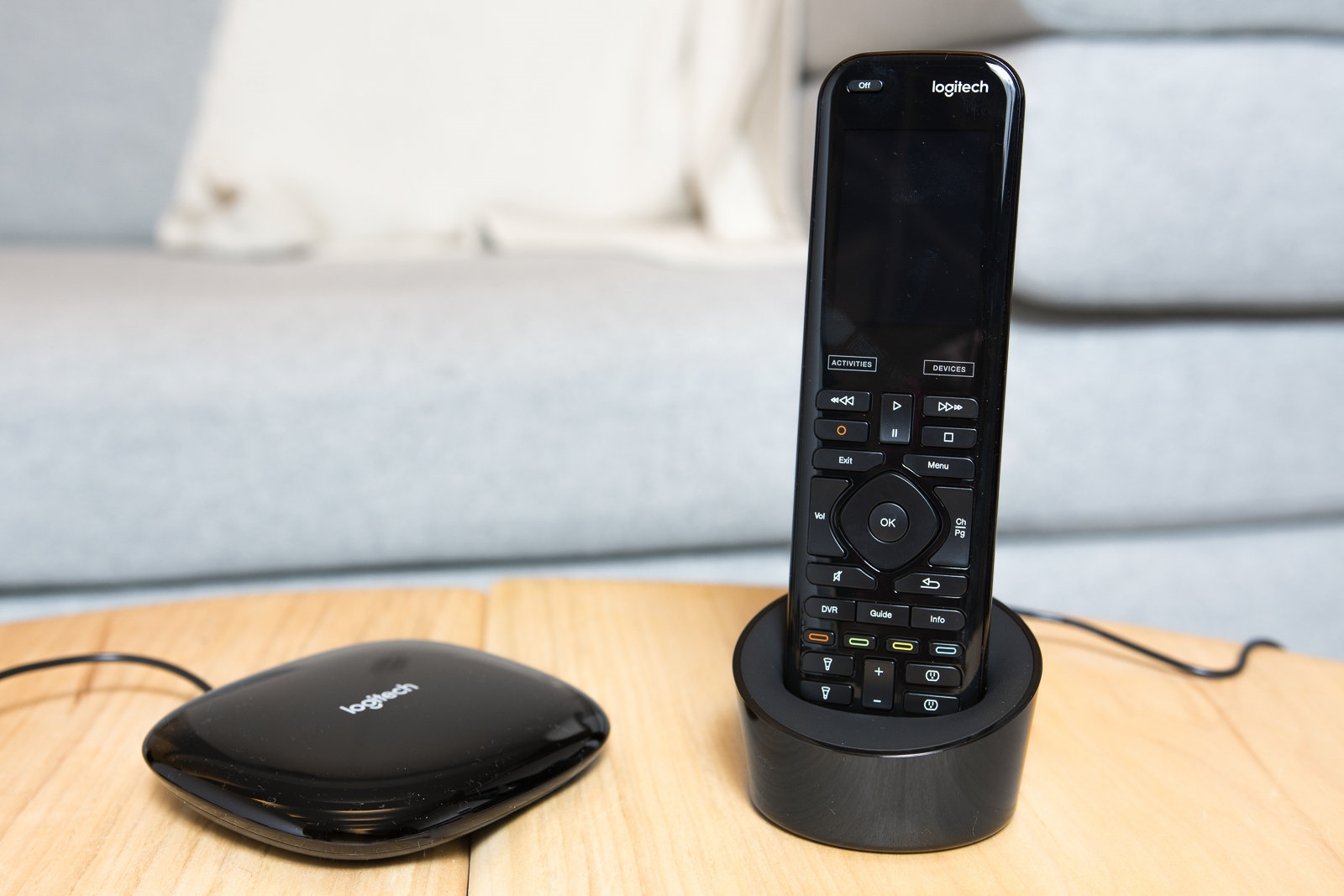
Like all the other Hub-based Harmony remotes, the Elite allows you to use the Harmony app in addition to the actual remote.
Finally, the Elite—like the Companion or any Hub-based Harmony remote—can work with a handful of smart-home devices, including Philips Hue and LIFX lights, Nest thermostats, SmartThings and Insteon hubs, Sonos wireless speakers, and even the IFTTT app. The Hub connects with all those devices via your home Wi-Fi network. With an Amazon Echo speaker and Alexa’s IFTTT channel, you can create recipes for voice control of any Harmony Hub–based system. Using this setup, we created recipes to turn a complex home theater system on and off with simple voice commands. If you want to add even more smart-home devices, Logitech offers a Z-Wave and Zigbee bridge for another $100.
The Elite is a pleasure to use, and it has the responsiveness and polish of a professionally installed control system, but it also costs a lot more than the Companion.
The app option
If you don’t want another handheld device but like the idea of universal remote control, an app may well do the job. We’re particularly fond of the Logitech Harmony app, which (as we note above) comes with any of the Hub-based remotes. You can also purchase the Harmony Hub as a standalone unit (it’s available without a remote) and just use the app.
The Harmony app runs on an iOS or Android device. Although it is intuitive and easy to use, we really don’t recommend it—or any other app-based universal remote—as your sole control option. That’s because a touchscreen requires you to look away from the TV screen and down at your device as you search for the right part of the screen to touch, making channel surfing and volume tweaking cumbersome. Plus, it’s a real pain to have to wake up your phone and wait for the app to reconnect with the system anytime you want to change the channel or the volume. Sure, you can disable sleep mode on your phone, but you’ll be draining your battery throughout the time you’re watching a movie or show.
The Pronto Peel is another app-based remote for people who don’t have overly complicated systems. The remote consists of two parts: a hardware module that connects to your smartphone or tablet via Bluetooth and beams out IR commands to your home theater gear, and an iOS or Android app for you to poke at. It also comes with a corded IR blaster for sending the command signals to hard-to-reach devices. Like the Harmony system, it can control components in a cabinet or closet as long as the Pronto module isn’t outside of Bluetooth range from your mobile devices.
In our tests, setup of the Pronto Peel system started off easy. The app walks you through a few simple steps to add a TV (or projector), receiver, DVD/Blu-ray player, streaming media player, cable/satellite set-top box, home theater in a box, or soundbar. After that it guides you through creating activities based on your source components. The process worked well for us until time came to create an activity for watching streaming video. The IR codeset that the Peel system found for one AV receiver didn’t include all of the video inputs on the receiver, so to make our Roku work, we had to move some of our HDMI cables around until we found the ones that corresponded to the five HDMI inputs that the Peel said the receiver had (our receiver actually had 10 HDMI inputs). Another work-around was to teach the correct input code to the Pronto Peel system, but the activity-creation step didn’t allow addition of the learned input, so that solution wasn’t perfect.
The Peel app is also more limited in what kinds of devices it can control. For instance, it can’t control any game system, whereas the Harmony app can control most game consoles as well as several smart-home devices.
Although the Peel app is not quite as intuitive as the Harmony app, we were able to get it to do everything we needed with a little finagling. If your AV system doesn’t go beyond the basic components and you want to be able to hide your gear and control it all cheaply, the Pronto Peel remote has you covered. However, if you’re not committed to the idea of an app for your home theater, we still think you’ll be happier with one of the Harmony remotes.
The competition
The Logitech Harmony Express universal remote features built-in Alexa voice control and has a much simpler design than the Harmony Companion or Elite, with just 10 action buttons and a navigation wheel. You can control your AV system with your voice by pressing the remote’s Alexa button and saying commands like “Turn on Fire TV,” “Open Netflix app,” or “Watch ESPN.” Logitech introduced a new setup app specifically for the Harmony Express, and it’s really easy to use to program the remote. We went through the setup process twice to test the remote with two different systems and it worked great both times. You can also link the Express system with existing Alexa smart speaker(s) for hands-free voice control.
The Express reliably executed the basic commands needed to control a full home-theater system (Onkyo AV receiver, LG OLED TV, Sony 4K Blu-ray player, and Apple TV) and a more basic living-room setup (Samsung LCD TV, Apple TV, xBox One X, and Polk soundbar). However, the limited button options make performing more advanced tasks challenging—like changing sound modes or using your AV receiver as a streaming source. The lack of a generic microphone button means you can’t automatically perform voice search through platforms other than Fire TV (you have to add skills through Alexa that may not always work reliably). Plus, this system is totally locked into the Alexa ecosystem.
Overall, we think the Companion and Elite have broader appeal as universal remotes, but if you like the idea of controlling a basic AV system with your voice (and having all of your Alexa functions at the touch of a button, as opposed to the always-listening Echo or Dot), the Express works well and is easy enough for anyone to use.
The Harmony 650, an older version of the Harmony 665, is a former pick that’s still available. Its button layout and setup process are identical to those of the Harmony 665, but the newer model can control two more devices. If you have fewer than eight AV devices to control and want to save a little money, this one is still a good option.
The Wayne-Dalton Teleport (WDHC-20) is unusual among the universal remotes available today in that it’s a combination of a universal IR remote and a Z-Wave controller. Compared with the more capable Harmony Companion, the Teleport is limited: It can control only four IR devices, has a much smaller database of IR codes, does not include Bluetooth, Wi-Fi, or USB connectivity, and controls only Z-Wave smart-home devices—so unless you own some Z-Wave devices, this model probably isn’t for you.
Universal Remote Control (the company) used to offer a range of good remotes, but the only URC model you can currently buy off the shelf is the clunky and difficult-to-program SR3, which controls only three devices. It’s more of a replacement remote than a universal remote.
RCA offers a four-device-capable “universal” replacement remote, as well as two-, three-, and six-device versions. The bigger RCA remotes even have programmable macros that let you power up several devices with one button press, but they aren’t capable of the kind of switching or complex control the Harmony remotes can accomplish.
Like RCA, One for All has several universal remotes in its lineup (for sale in the United States, at least), including the Simple 4; these have similarly limited programmability and support only three or four devices.
The Caavo Control Center + Universal Remote combines a handheld remote and an HDMI switcher/control box (with four HDMI inputs and one output). The remote itself is a sleek, stripped-down design with important buttons like home, microphone, volume, back, menu, and more (but no backlighting). The control box supports 4K/HDR10 pass-through and it adds an on-screen user interface to your system through which you can easily switch sources, voice-search content across platforms, unite your streaming apps from different devices, and set up favorites. The on-screen interface walks you clearly through the setup process; we set up the Caavo system twice to control two different systems and it reliably controlled both without any major problems. It also works with Alexa and Google Assistant for hands-free voice control, and Caavo recently added some new features, like integrated Sonos control, a universal control app for iOS, and a Family Care feature that lets you monitor what your kids may be watching and post on-screen messages via the mobile app.
However, because the Caavo system is more of a control platform than a universal remote, it won’t be the right fit for everyone. You can only connect HDMI sources to the control box, the remote’s limited button options can make performing more advanced tasks challenging, and you have to subscribe to the Caavo service ($4 per month, $40 per year, or a one-time lifetime subscription fee of $130 at the time of this writing). Plus, adding an interface on top of your sources can slow down some processes (like voice search). But if you’re looking for a highly affordable way to add more 4K/HDR-friendly HDMI inputs to your system and you like the idea of controlling your gear through an on-screen interface instead of “activity” buttons on a remote, the Caavo system is a simple, reliable option that works well.
Neeo was acquired by custom-home-automation company Control4 in February, so the company’s universal remotes will no longer be sold directly to consumers.
This guide may have been updated by Wirecutter. To see the current recommendation, please go here.
When readers choose to buy Wirecutter’s independently chosen editorial picks, Wirecutter and Engadget may earn affiliate commissions.
(48)

